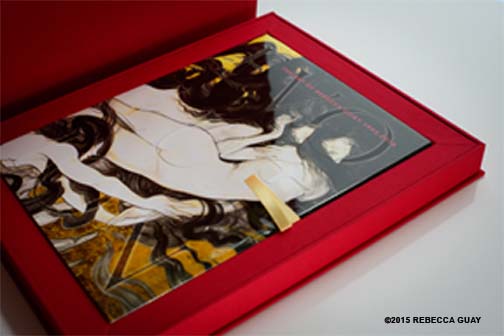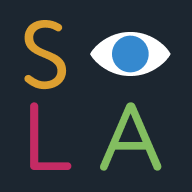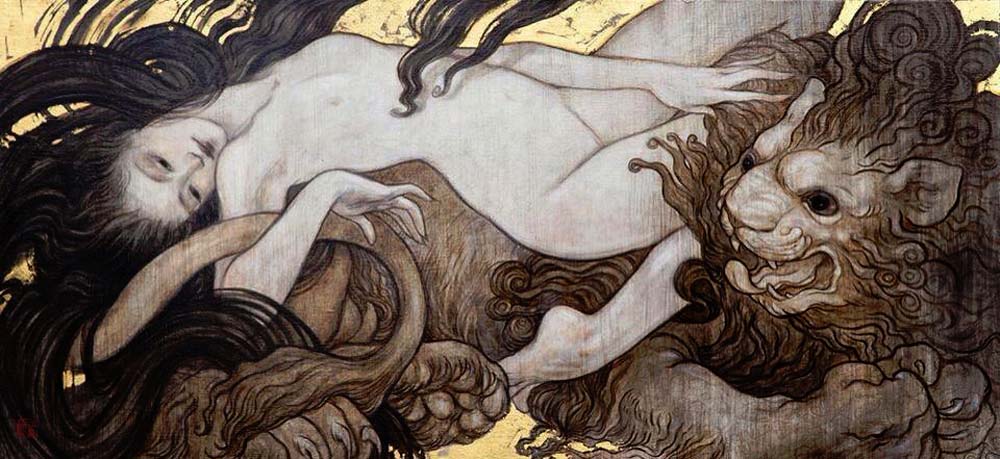Rebecca Guay interviewed by Illustration West 54 Show Chair, Marc Scheff

You are one of the most accomplished artists working in our field. You’ve done comics, books, graphic novels, Magic cards, commercial illustration for loads of clients, and now are a well-established gallery painter. What pushes you to do all these different things, why not stick to just a few?
- I have indeed worked in many different progressions of the industry of art – but importantly – have focused very specifically for long periods of time in certain places – first many years in comics ( with just a few small jobs on the side for kids books work, like for Cricket Magazine) then moving into Fantasy with almost exclusives MTG and Role playing games for a number of years with some work in comics again here and there (and then STARTING in 2005 to develop my personal and gallery work whenever I had a free moment). Then almost totally in Children’s books for several years (while doing some RPG on the side) then back to Comics for another 3-4 years. Since 2011 its been totally about gallery work – a leap I was able to make after completing the last two graphic novels back to back.
Now my gallery sales have surpassed what I made yearly within publishing (I also find it so immensely rewarding to both do this work and to teach how and illustrator might shift to gallery – that I think this is where I will be staying.)
But I’ve been very very focused within each pursuit – and didn’t jump broadly back and forth stylistically across things while in the midst of any one path and even within the areas of illustration there is a fair amount of crossover stylistically with my work – so I wasn’t making big shifts in WHAT I do.The biggest most deliberate shift came with the new direction in personal and gallery work – so in my mind I’ve essentially only taken ONE major shift – and that’s from publishing to gallery.
I know that you are committed to your practice as a dancer. This sense of movement and emotion is clear in your work. How much of the movement in your paintings is choreographed/planned decision-making and how much is going with the flow/discovering the rhythm of a painting as you go through?
- There is a great beauty and centering in honoring the practice of classical ballet – if you come every day to the barre and center you mind and train your body-rewards happen – much the same way when you come to the studio and train as an artist, NEVER easy but always fulfilling.
Ballet is an ever striving pursuit to grace and detail, as well as blisteringly hard physically. I’ve done other physically challenging things for periods of time, running, P90x, etc… but always come back to ballet as its the only thing that feeds my mind, body and artistic spirit – I’ll never ever get bored because I will never ever master the subtitles of the form. The minute attention the details in subtle gesture effects my paintings constantly – training your eye to see the minuscule details that change the nature of an image is essential to threading the needle in a piece – if you miss it – the piece is NOT special – if you find it the piece is miraculous – and it a hair’s breadth difference.
I start with gestural sketches – identifying composition and the major feeling – but often i will allow things to happen while working that grow in the moment so long as they do not change the intention of the piece.
You founded both the Illustration Master Class (IMC) and SmArt School. What is one way you see these programs evolving over the next year to five years?
- I respond to what the students need and what reflects the places where artistes have success within the industry yearly or even by the semester.
I don’t believe in a five year plan for either program as so much can change – and should change in order to be the most effective programs – I could make a five year GUESS – but that all it will be.
I will say that we will always teach art and we will always be taught by working professionals. We will grow organically based upon the need of the students – and not based upon larger ideas of expansion. I will always run it as efficiently as possible and not reach farther in any one year past what can be handled with grace. I will always strive to bring in great people and then let them do what they do best without bureaucracy.
Has teaching/giving birth to these programs affected your work in any way?
As a teacher you are always again and again reminded about what matters most to you as you teach that philosophy to you students.
- Teaching is so much more rewarding than is easy to put into words – seeing the shape and landscape of the industry changing because students who have come through programs one started – its JOYOUS to see – amazing.
There are certainly more people relying on me all the time now – many many more – which does make things very much more complex sometimes and there are periods of my life in which I administrate rather than paint – but I can compartmentalize enough so that I can also remain painting. Not becoming overwhelmed and being good at multitasking is very important!
What new projects might we see from you in the next year or two?
- In my work as an artist I’m in a group show at Jonathan LeVine in August and I have my next solo show scheduled for Fall 2016 in NYC in connection with R. Michelson – and this year will be spent painting for that show.

 ©2015 Rebecca Guay
©2015 Rebecca Guay